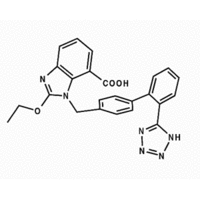McMurray JJV, Ostergren J, Swedberg K, et al. Effects of candesartan in patients with chronic heart failure and reduced left-ventricular systolic function taking angiotensin converting-enzyme inhibitors: the CHARM-Added trial. Lancet 2003; 362: 767-771.
* PRACTICE RECOMMENDATIONS
The addition of candesartan (Atacand) to an angiotensin-converting enzyme (ACE) inhibitor and other treatment reduces cardiovascular death and hospital admissions of patients with congestive heart failure (CHF). As in studies conducted with valsartan (Diovan), candesartan added to an ACE inhibitor does not decrease overall mortality. Clinicians should add candesartan to the medical regimen in nonallergic CHF patients with an ejection fraction of 40% or lower who are already on an optimal dose of an ACE inhibitor.
* BACKGROUND
Despite high doses of an ACE inhibitor, some angiotensin II is still produced by the kidney. ARB treatment, in addition to an ACE inhibitor, might offer a benefit. The addition of valsartan to an ACE inhibitor in a previous study decreased cardiovascular mortality but did not affect overall mortality.
A recent study combining valsartan and captopril (Capoten) for patients with a recent myocardial infarction and heart failure showed increased adverse events without any change in survival compared with captopril or valsartan alone. (1) This study evaluated the addition of the ARB candesartan to patients with heart failure already receiving an ACE inhibitor.
* POPULATION STUDIED
The investigators enrolled patients aged 18 years or older with left ventricular ejection fraction of 40% or lower and New York Heart Association functional class II-IV CHF who were on optimal, stable doses of ACE inhibitors. Other variables, such as age, race, comorbidities, and medications were similar to typical family practice patients with CHF.
* STUDY DESIGN AND VALIDITY
Of the 2548 subjects enrolled, 1276 were assigned to receive candesartan and 1272 to receive placebo. Starting doses were 4 to 8 mg once daily, and the dose was doubled every 2 weeks as tolerated until a target dose of 32 mg was reached. Patients were seen at 2 weeks, 4 weeks, 6 weeks, 6 months, and then every 4 months until the end of the trial. The median follow-up was 41 months.
The study was well done. Randomization was computer-generated, both subjects and investigators were blinded to treatment assignment, and allocation was concealed. The analysis was intention-to-treat and included all randomized patients. The patient population was mostly male (79%) and of European decent (90%). The randomization scheme ended up placing more smokers in the placebo group (18.5% vs 15.2%), which could have increased the cardiovascular mortality in this group. Almost all (99.8%) patients were followed completely through the study, with only 4 patients lost to follow-up. (Level of evidence: 1b)
* OUTCOMES MEASURED
The primary outcome was cardiovascular death or unplanned admission to the hospital for worsening CHF. All-cause mortality and the numbers of hospitalizations for any reason were also measured.
* RESULTS
Overall, 483 (37.9%) patients in the candesartan group and 538 (42.3%) in the placebo group experienced the primary outcome of cardiovascular death or unplanned admission to the hospital for worsening CHF (P=.011; number needed to treat [NNT] =23 for 41 months).
Taking the outcomes individually, cardiovascular mortality was lower in the treated patients (23.7% vs 27.3%; NNT=28; 95% confidence interval [CI], 13-200), as was the admission rate due to CHF (24.2% vs 28.0%; NNT=26; 95% CI, 12-90). Unlike a previous study with valsartan, patients receiving an ARB, ACE inhibitor, and beta-blocker did not have a higher mortality than patients not receiving a beta-blocker.
Overall all-cause mortality was not improved with the addition of the ARB, which was approximately 30% in both groups. Almost 1 in 4 (24.2%) patients in the candesartan group and 18.3% in the placebo group discontinued the study medication because of an adverse event or abnormal lab value (P=.0003). By 6 months systolic blood pressure was lowered by 4.6 mm Hg and diastolic blood pressure by 3.0 mm Hg more in the candesartan-treated group (P=.004).
REFERENCE
(1.) Pfeffer MA, McMurray JJK, Velazquez EJ, et al. Valsartan, captopril, or both in myocardial infarction complicated by heart failure, left ventricular dysfunction, or both. N Engl J Med 2003; 349:1893-1906.
Ginger Wiley, MD, and Charles Cole, MD, Department of Family Practice, University of Virginia Health Sciences Center, Stoney Creek Family Practice, Nellysford, Va. E-mail: cjc4y@virginia.edu.
COPYRIGHT 2004 Dowden Health Media, Inc.
COPYRIGHT 2004 Gale Group



